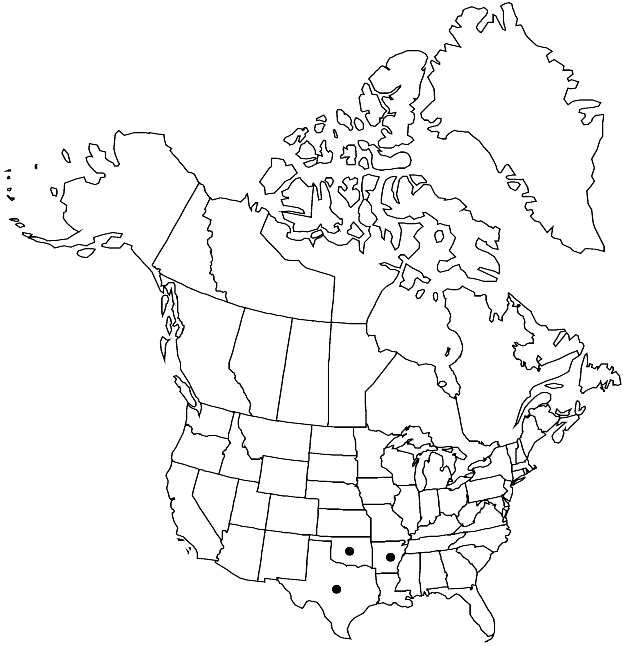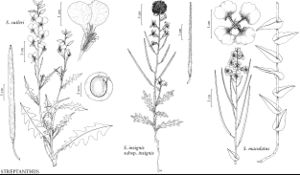Difference between revisions of "Streptanthus maculatus"
J. Acad. Nat. Sci. Philadelphia 5: 134, plate 7. 1825.
FNA>Volume Importer |
FNA>Volume Importer |
||
| Line 11: | Line 11: | ||
|name=Streptanthus maculatus subsp. obtusifolius | |name=Streptanthus maculatus subsp. obtusifolius | ||
|authority=(Hooker) Rollins | |authority=(Hooker) Rollins | ||
| − | }}{{Treatment/ID/Synonym | + | }} {{Treatment/ID/Synonym |
|name=Streptanthus obtusifolius | |name=Streptanthus obtusifolius | ||
|authority=unknown | |authority=unknown | ||
| Line 29: | Line 29: | ||
|elevation=200-500 m | |elevation=200-500 m | ||
|distribution=Ark.;Okla.;Tex. | |distribution=Ark.;Okla.;Tex. | ||
| − | |discussion=<p>Streptanthus maculatus is distributed in Arkansas in Garland, Hot Springs, Montgomery, Pike, Polk, Pulaski, and Saline counties; in Oklahoma in Latimer, Le Flore, McCurtain, and Pushmataha counties; and in Texas in Anderson, Cherokee, Gregg, and Smith counties.</p><!-- | + | |discussion=<p><i>Streptanthus maculatus</i> is distributed in Arkansas in Garland, Hot Springs, Montgomery, Pike, Polk, Pulaski, and Saline counties; in Oklahoma in Latimer, Le Flore, McCurtain, and Pushmataha counties; and in Texas in Anderson, Cherokee, Gregg, and Smith counties.</p><!-- |
| − | --><p>R. C. Rollins (1993) divided Streptanthus maculatus into two subspecies based on the presence versus absence of the subapical callus on sepals and on leaf shape. Subspecies maculatus was said to differ from subsp. obtusifolius by the absence (versus presence) of the sepal callus and by having lanceolate (versus broadly ovate) cauline leaves. These highly variable characters do not covary.</p> | + | --><p>R. C. Rollins (1993) divided <i>Streptanthus maculatus</i> into two subspecies based on the presence versus absence of the subapical callus on sepals and on leaf shape. Subspecies maculatus was said to differ from subsp. obtusifolius by the absence (versus presence) of the sepal callus and by having lanceolate (versus broadly ovate) cauline leaves. These highly variable characters do not covary.</p> |
|tables= | |tables= | ||
|references= | |references= | ||
| Line 54: | Line 54: | ||
|publication year=1825 | |publication year=1825 | ||
|special status= | |special status= | ||
| − | |source xml=https://jpend@bitbucket.org/aafc-mbb/fna-data-curation.git/src/ | + | |source xml=https://jpend@bitbucket.org/aafc-mbb/fna-data-curation.git/src/8f726806613d60c220dc4493de13607dd3150896/coarse_grained_fna_xml/V7/V7_1249.xml |
|tribe=Brassicaceae tribe Thelypodieae | |tribe=Brassicaceae tribe Thelypodieae | ||
|genus=Streptanthus | |genus=Streptanthus | ||
Revision as of 18:55, 18 September 2019
Annuals; (glaucous), usually glabrous throughout (sometimes stem bases pubescent). Stems unbranched or branched distally, 1.7–10.6 dm, (trichomes 0.05–0.5 mm). Basal leaves (soon withered); rosulate; petiolate; blade similar to cauline. Cauline leaves: blade broadly ovate to broadly oblong or lanceolate, 2–15 cm × 10–80 mm, (smaller distally), base amplexicaul, margins entire, (apex acute to acuminate or rounded). Racemes ebracteate, (dense or lax). Fruiting pedicels divaricate-ascending, (straight), 4–7 mm. Flowers: calyx campanulate; sepals (erect), purplish, 4–9 mm, (lateral pair rarely with subapical callus, 0.1–0.3 mm), not keeled; petals (widely spreading to somewhat reflexed), magenta (with deep purple center), 11–21 mm, blade 6–12 × 5–11 mm, margins not crisped, claw 5–10 mm, narrower than blade; stamens tetradynamous; filaments: median pairs (distinct), 5–7 mm, lateral pair 3–5 mm; anthers (all) fertile, 3–4 mm; gynophore 0.7–1.5 mm. Fruits ascending, smooth, straight, flattened, 6–11.4 cm × 2–3 mm; valves each with prominent midvein; replum straight; ovules 56–92 per ovary; style 1–2.5 mm; stigma strongly 2-lobed. Seeds broadly oblong, 2–2.5 × 1–1.3 mm; wing 0.2–0.3 mm wide, continuous.
Phenology: Flowering Apr–May.
Habitat: Near creeks, roadside banks, moist bottoms, open oak woods, moist land in woods, rocky bluffs, ledges, dry talus slopes, rock crevices, pine-hickory forests
Elevation: 200-500 m
Distribution

Ark., Okla., Tex.
Discussion
Streptanthus maculatus is distributed in Arkansas in Garland, Hot Springs, Montgomery, Pike, Polk, Pulaski, and Saline counties; in Oklahoma in Latimer, Le Flore, McCurtain, and Pushmataha counties; and in Texas in Anderson, Cherokee, Gregg, and Smith counties.
R. C. Rollins (1993) divided Streptanthus maculatus into two subspecies based on the presence versus absence of the subapical callus on sepals and on leaf shape. Subspecies maculatus was said to differ from subsp. obtusifolius by the absence (versus presence) of the sepal callus and by having lanceolate (versus broadly ovate) cauline leaves. These highly variable characters do not covary.
Selected References
None.
